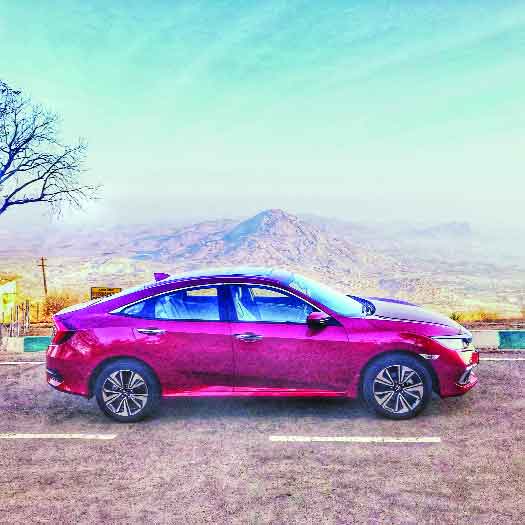The new Honda Civic is definitely gifted with awesome looks, with or without its front-end. But will this tenth-generation set the roads alight in India as the previous Civic did? The launch of the first Civic by Honda Cars India a decade and a half ago heralded a revolution. The car, which was the eighth-generation of the Japanese carmaker’s popular sedan (and hatchback in European countries), was a sales success. But Honda was not able to continue the Civic’s successful run in India for too long for a multitude of reasons. However, one has to admit that a major reason why sales of the Civic tailed off was India’s growing love affair with oil-burners, that is diesel cars. Honda globally did not have a smaller diesel motor that they could bring to India back then and that played a role in the company ceding the segment to its rivals, first the Chevrolet Cruze and then further on the Toyota Corolla Altis and Skoda Octavia.
But now the Honda Civic is back and after skipping one global generation, Honda cars India has brought in the tenth-generation. This time, they have ensured that it has a diesel engine alongside a zippy petrol motor. So let us deal with the headline numbers first. The 1.6-litre turbocharged diesel engine, which shares duty on the other recently introduced Honda, the CR-V, produces a decent 120 horsepower. The company claims that thanks to their “Earth Dreams” technology, the Civic i-DTEC returns an astounding 26 km per litre under Indian test conditions. The Civic also comes with a 1.8 litre i-VTEC petrol that produces a fairly decent 140 horsepower. Disappointingly for Civic fans, Honda has not brought either of the powerful engines that do service on this particular sedan in the United States, which are a 158 horsepower 2.0 i-VTEC and the very impressive 200 horsepower turbocharged 1.5-litre engine. Of course, India is a fuel-economy obsessed market but Honda has bucked the trend in the past with cars like the Honda Accord V6, which all car nuts in India who drove, including me, remember as a rocket, a thirsty rocket, but a rocket nonetheless. Even today, good second-hand examples of this car, like the original Honda City VTEC, which was another amazing car, command top dollar.
But can the new Honda Civic become a future classic like its illustrious predecessors? Well, it does certainly knock the door on the looks front. Yes, the snout of the car is a bit incongruous. In fact, the chrome slab across the front grille, which is apparently a Honda signature, does make the car look quite weird. Because from the side and particularly from the rear, it looks fabulous. In fact, the rear three-quarter look of this vehicle is among the prettiest I have seen on a car in India. This car looks as attractive as a supermodel sashaying down the ramp with some toilet paper stuck to her heel. Still very, very pretty but you know, something is off.
What I did find interesting is that despite the looks, particularly the coupe-shaped sloping roofline which makes you assume that the car would be very tight inside, it really is not. I will not say it is the most spacious car in its segment but it does not feel cramped. After all, the Civic sedan is designed for the American market, where people are not quite small or short. Headroom in the front is not bad at all, and I am 5’11.” In the rear, even with the front seats pushed back, space is more than sufficient for myself and while three adults on the rear bench is a squeeze on any car, it will not feel so bad on the Civic. The only issue is possibly the fact that in order to get the space in the front and rear, the seats ride rather low and although the Indian Civic is 10 mm higher than the outgoing model, ingress and egress is a bit clumsy the first few times until you get the hang of it.
But you never buy a car for its looks alone, you do care about the performance too. So how is the new Civic? Well, first a disclaimer, this is a first drive, not a detailed test drive where I drive and experience a vehicle over a few days during my commute. We drove the car around the highways near Bengaluru airport and up the twisty roads on Nandi Hills. Initially, I had the i-DTEC which comes with a six-speed manual transmission. Now, I have a strong opinion about six-speed manual transmissions in India because I still believe it is one gear too many on any car. That said, on the highway you can easily put the car into sixth and just cruise at 80-100 km per hour, the diesel purring along. What does not purr along are the tyres? Because of the need to derive higher fuel economy, the i-DTEC comes with low rolling resistance tyres and those are noticeably noisy. You can drown that out by pumping the volume on the smart infotainment system, which is similar to those on other new Hondas, and comes with support for Apple CarPlay and Android Auto, standard across variants.
Now, on the twisty sections you really do need to mash the gears to keep the motor in its narrow power band. While the car does take the corners very steadily indeed, you do feel that it could do a bit more. Maybe with grippier tyres it could. Then again, even with enthusiastic driving, the Civic Diesel returned almost 15 km per litre. This is clearly a car designed to be an economical long-distance hauler, but a boy racer.
So on to the iVTEC, first things first, there is no manual version on this Civic. Nope. Nada. Nyet. What you get is Honda’s very nice Continuously Variable Transmission (CVT) with a Torque Converter and seven forward speeds as standard, as well as a paddle-shift system when you want to have fun. Now, Honda’s CVTs are very smooth — I loved the CVT on the diesel Amaze for example — but they are not designed again for very enthusiastic driving. On regular day-to-day driving on the highway and in the city, gear shifts are brilliant and kick-down power when you need to get a move on gets delivered promptly. But you do start to sense some shift-lag when you start using the paddles a lot. Possibly I am saying this because dual-clutch gearboxes and their millisecond shifts have spoiled me. While this CVT is not what I would call lazy, it again feels tuned more to regular urban commuting.
And you know what? Urban commuting is what most buyers of the Civic will do, and once you begin to live with it, you can work your way around the CVT transmission and figure it out. As such both the iDTEC and iVTEC Civics are very well suited for that role and look fantastic as well.
The problem Honda India faces has actually less to do with the Civic and more to do with the segment, because the segment is moribund. India’s love affair with the Sports Utility Vehicle continues, anybody buying a car in the Rs 15-18 lakh range is looking lustfully at the Hyundai Creta. The Civic, which one expects to match the Corolla Altis for price, meaning it would be around the Rs 18-24 lakh segment, will have people look at the Hyundai Tucson, or have people who want space just look at the Toyota Innova. There is no doubt the new Honda Civic is a good car and an excellent looking one at that, but I’m not sure it can make the Indian buyer start looking at sedans again.
Courtesy: The Pioneer
Writer: Kushan Mitra








 OpinionExpress.In
OpinionExpress.In















Comments (0)